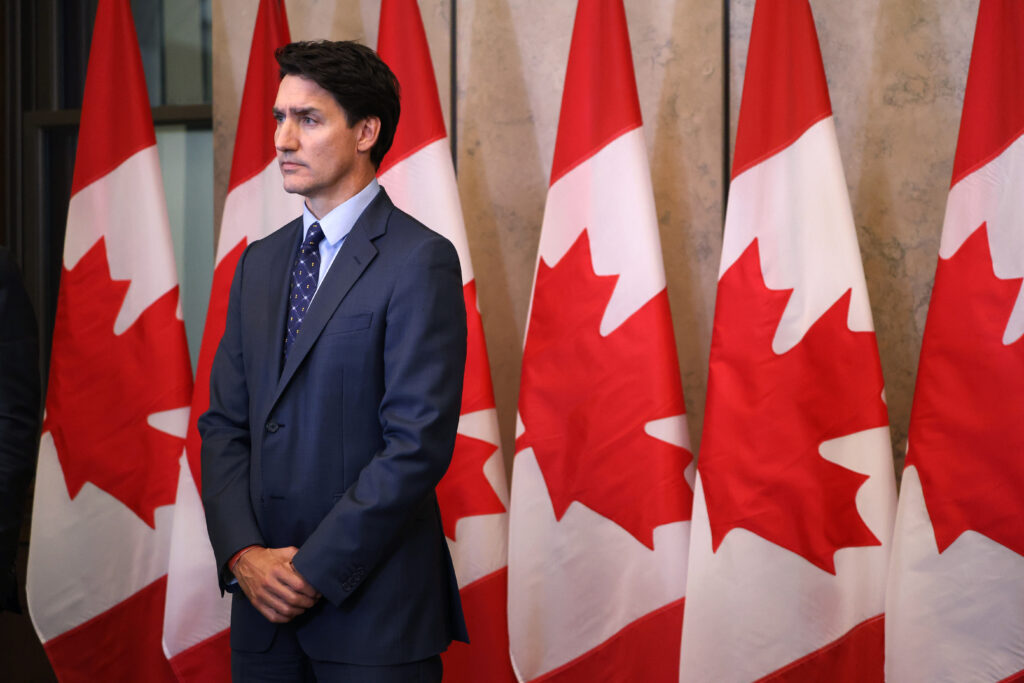Interviews / Political and Geostrategic Observatory of the United States
9 January 2025
Justin Trudeau’s Departure: What Are the Prospects for Canada?

The Prime Minister of Canada, Justin Trudeau, announced on January 6 that he would step down from power and his position, which he has held since the fall of 2015. This decision comes as the President-elect of the United States, Donald Trump, intensifies provocations and economic threats against the country. As Canada, traditionally a steadfast ally of Washington, faces these unprecedented tensions, this announcement plunges the nation into a period of uncertainty, both domestically and internationally. How can Justin Trudeau’s decision be explained? What has been the impact of Donald Trump’s statements? What are the future prospects for Canada? The answers from Romuald Sciora, associate researcher at IRIS and director of the Political and Geostrategic Observatory of the United States at IRIS.
In power since 2015, Canadian Prime Minister Justin Trudeau announced his resignation on January 6. What can be said about his nine years at the helm of Canada?
Since coming to power in 2015, Justin Trudeau has shaped Canadian politics with ambitious reforms, but also with controversies that have tarnished the aura of renewal he represented in his early years. Elected on a progressive platform, he championed values such as gender equality, diversity, and the fight against climate change. His commitment to welcoming Syrian refugees in 2015 and his policies favoring immigration helped create an image of international openness.
However, these ambitions encountered significant challenges. Trudeau’s immigration policy, though initially praised, showed its limits. Bureaucratic delays for asylum applications grew longer, creating tensions in local communities. Furthermore, his government struggled to effectively address the integration challenges faced by newcomers, particularly in employment and housing, fueling criticism over a lack of preparation and coordination.
Economically, Trudeau implemented expansionary fiscal policies, increasing public spending to stimulate the economy. These measures allowed Canada to maintain stable growth until the Covid-19 pandemic. However, the management of public debt, which has risen significantly since 2020, has drawn criticism, particularly from conservatives.
On climate change, Justin Trudeau adopted a mixed policy. On one hand, his government introduced a carbon tax, positioning Canada as a climate leader among G7 countries. On the other hand, he supported controversial pipeline projects, notably the Trans Mountain pipeline, which frustrated part of his progressive electorate.
Finally, his legacy is marked by ethical scandals, such as the SNC-Lavalin affair, and growing tensions with certain provinces, notably Alberta and Quebec. In sum, his political legacy is a mix of modernity and compromise, leaving behind a deeply divided country.
To what extent has the re-election of Donald Trump, who wants to drastically increase tariffs between the United States and Canada and even mentioned his desire to see the two countries “merge,” impacted Trudeau’s decision? How is the relationship between Ottawa and Washington likely to evolve?
Donald Trump’s re-election, announced in November 2024, undoubtedly influenced Justin Trudeau’s decision to step down. Relations between Ottawa and Washington under Trump were particularly challenging. From his first term, Donald Trump imposed tariffs on Canadian steel and aluminum, plunging the two countries into an unprecedented trade war. These tensions eased under Joe Biden’s presidency, but the prospect of a second Trump term has revived fears in Canada.
Trump’s recent remarks have particularly shocked Canadian public opinion. By mentioning a possible “merger” between the two countries and referring to Canada as the “fifty-first state,” Donald Trump not only questioned Canadian sovereignty but also humiliated Justin Trudeau, calling him merely a “governor.” The perception that Trudeau failed to respond firmly to these provocations fueled criticism. Many Canadians reproach him for adopting too conciliatory a stance toward a president seen as aggressive and contemptuous.
Furthermore, Canadian public opinion, traditionally favorable to cordial relations with the United States, is becoming increasingly polarized in response to Trump’s policies. Managing this polarization would have complicated Trudeau’s position had he chosen to run again. His departure thus paves the way for political renewal, which could redefine Ottawa’s priorities in relation to its southern neighbor.
As the “Trudeau era” comes to an end, what are the political dynamics at play in Canada and what prospects seem to be emerging for the country?
The end of the Trudeau era marks a turning point in Canadian politics. The Liberal Party, weakened by a decade in power and internal divisions, faces a strengthened conservative opposition. Under the leadership of Pierre Poilievre, the Conservatives have adopted a populist stance, denouncing Justin Trudeau’s progressive policies and promising rigorous economic management.
At the same time, the New Democratic Party (NDP) on the left could play a key role, particularly by capitalizing on the disillusionment of progressive voters who had previously voted for the Liberal Party. Current political dynamics suggest increased polarization between a conservative right and a fragmented left, making parliamentary alliances more complex.
Regionally, Quebec could play a decisive role. With the rise of the Bloc Québécois, the discourse on provincial autonomy is gaining ground, reflecting dissatisfaction with Ottawa. Alberta and Saskatchewan, rich in energy resources, continue to demand more economic and political recognition.
Geopolitically, the re-election of Donald Trump raises growing concerns for the future. His verbal provocations toward Canada are accompanied by an aggressive trade policy. But beyond these immediate tensions, a broader question arises: Could the United States’ attitude toward Canada eventually become an existential threat? Canada, rich in strategic natural resources, could face increasing pressures from its powerful neighbor. This fear, still in its early stages, is beginning to take root in some Canadian strategic circles.
In the face of these challenges, post-Trudeau Canada will have to navigate a complex geopolitical landscape. While his departure ushers in a period of uncertainty, it also presents an opportunity to redefine Canada’s role on the international stage and strengthen its sovereignty in the face of sometimes unpredictable neighbors.

